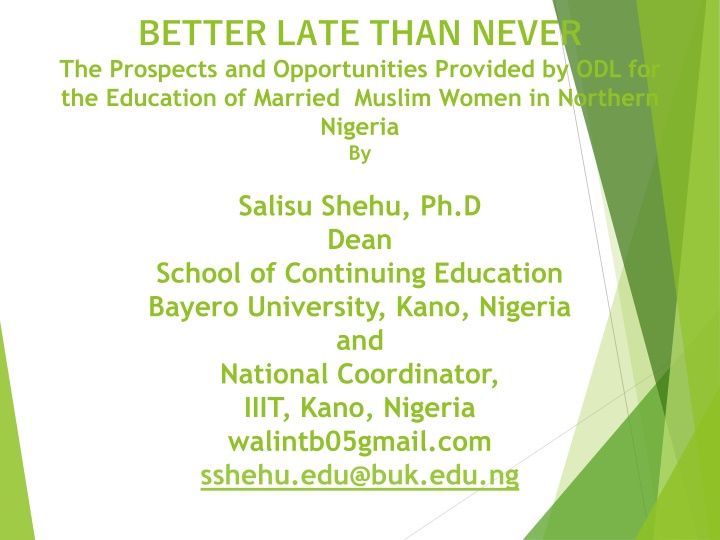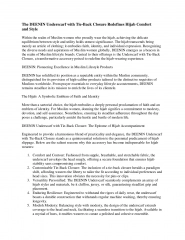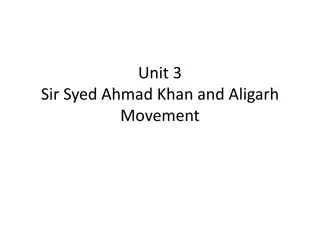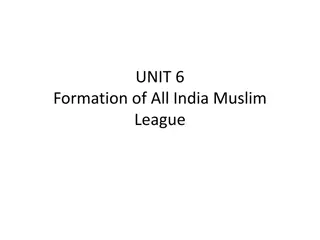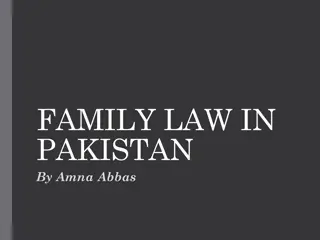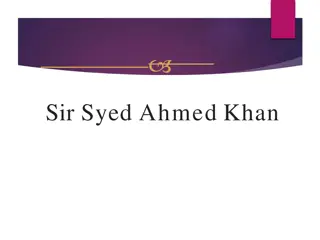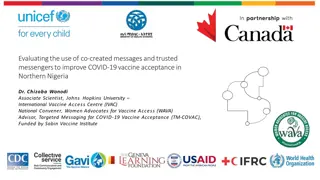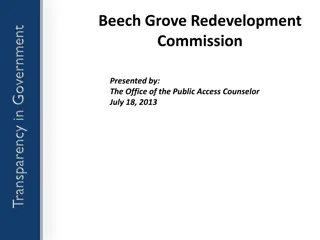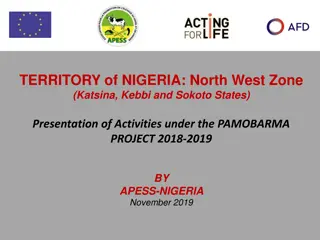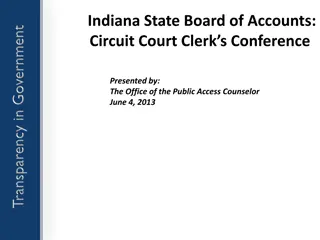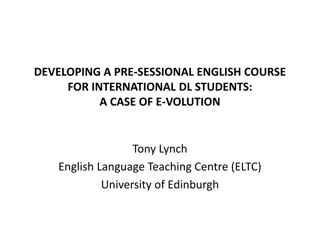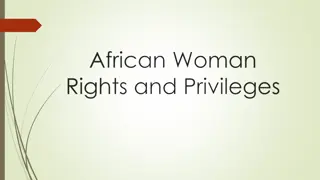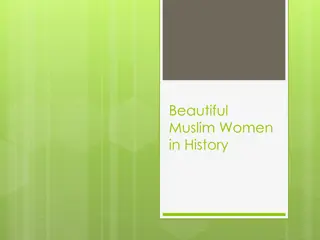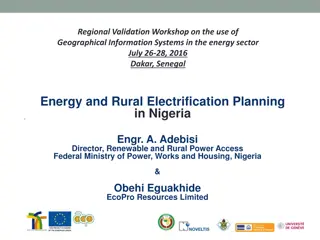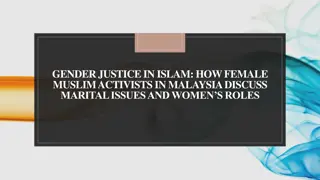Prospects of ODL for Education of Married Muslim Women in Northern Nigeria
Historical, cultural, and religious factors have led to educational imbalances between Northern and Southern Nigeria, particularly affecting the education of married Muslim women in the North. This article by Salisu Shehu explores how Open and Distance Learning (ODL) can provide prospects and opportunities for these women to access education despite early marriage practices. The paper highlights the benefits of ODL in enabling flexible and affordable educational options for disadvantaged groups, focusing on empowering married Muslim women in the North.
Download Presentation

Please find below an Image/Link to download the presentation.
The content on the website is provided AS IS for your information and personal use only. It may not be sold, licensed, or shared on other websites without obtaining consent from the author.If you encounter any issues during the download, it is possible that the publisher has removed the file from their server.
You are allowed to download the files provided on this website for personal or commercial use, subject to the condition that they are used lawfully. All files are the property of their respective owners.
The content on the website is provided AS IS for your information and personal use only. It may not be sold, licensed, or shared on other websites without obtaining consent from the author.
E N D
Presentation Transcript
BETTER LATE THAN NEVER The Prospects and Opportunities Provided by ODL for the Education of Married Muslim Women in Northern Nigeria By Salisu Shehu, Ph.D Dean School of Continuing Education Bayero University, Kano, Nigeria and National Coordinator, IIIT, Kano, Nigeria walintb05gmail.com sshehu.edu@buk.edu.ng
IINTRODUCTION A combination of historical, religious and cultural factors have been responsible for educational imbalance between the Northern and Southern parts of Nigeria. The latter has been far ahead than the former since pre-independence times. In the historical perspective, the Southern part had had earlier contact with the Christian Missionaries who introduced Western Education. This explains the fact that the South, that is predominantly Christian got introduced to it (Western Education) earlier than the North that is predominantly Muslim, and thus, invariably put the former ahead.
Introduction contd. The imbalance persisted generally, but has been much more glaring in the aspect of girl child /women education. Certain cultural factors and misconceived religious precepts are responsible for this specific aspect of the educational imbalance. The North being predominantly Muslim, as earlier stated, is inclined to marrying off girl children in their tender ages, a practice that abruptly brings an end to their education.
Introducton contd. Already introduced to matrimonial life, the possibility and chances of renewing their pursuit for education or initiating another, whether at the secondary school, or tertiary/higher level, are also inhibited. With Open and Distance Learning, (ODL) however, all hopes are not lost.
Introduction contd. Offered outside the conventional educational setting and arrangements, the ODL offers opportunities for access to education, especially to disadvantaged groups in ways that are flexible and also affordable. This paper identifies the prospects of ODL amongst Muslim married women in Northern Nigeria. It also explores the comparative advantages it offers to them. It finally attempts to propound modalities and arrangements through which it can best be engendered to them.
EDUCATION AND NATIONAL DEVELOPMENT What the NPE Says in this Regard education is the most important instrument of change in any society . And that any fundamental change in the intellectual and social outlook of any society has to be preceded by an educational revolution
Nelson Mandela Education is the most powerful weapon which you can use to change the world. No country can really develop unless its citizens are educated.
WHY ODL? Jegede (2017) presents justification Growth in population and the attendant escalating demand for education at all levels The difficulty of resourcing education through the traditional means of formal education
WHY ODL? Contd Jegede s Justification (cont;d) Provide education for all irrespective of environmental, social or cultural circumstances Adequately meet the huge unmet the demand for education at all levels and by all sectors. Social goals of boosting rural economy, eradicate poverty, eliminate illiteracy, and boost technological and computer literacy.
Demographic Indices and the Challenge of education for all within the Regular/Convetional Setting Population 190,886,311 Nigeria s grows by 2.7 % annually, population will double by the year 2066. 110 million youth under the age of 25 years rising to over 200 million in 50 years time.
Provision of ODL in the National Policy on Education policies which were to be directed towards ensuring that there are equal and adequate educational opportunities at all levels . make life-long education the basis for the nation s education policy after primary education an individual will be able to choose between full-time studies, combining work with studies alternative mode of learning the education system structured to develop the practice of self-learning .Provision
Demography Continued 22.1million out of 42.1 million in primary schools; 10.4 million out 33.9 million Nigerians eligible for secondary education, are in school Has the highest rate of out-of- school children in the world.
State of education in Northern Nigeria The Picture with Particular Reference to JAMB 2008 Total No. of Applicants all over the Country: Over 1,000,000 Total No. of Applicants from all the Northern States (without Benue and Kogi) 73,000 Kano State vs Imo State: Kano(10,000); Imo (100,000) Source : JAMB
2010 Total No.of Applicant all over the Country: Over 1,375,652 States with the Highest No.of Applicants: Imo (111,613); Delta (86,955) States with the Lowest No.of Applicants: Zamfara (3,568); FCT (2,393) Source: JAMB
2012 Total No.of Applicants all over the Country: Over 1,503,931 States with the Highest No.of Applicants : Imo (123,865); Anambra (82,204); Osun (73,935); Oyo (71,272) Ogun (71,173) States with the Lowest No.of Applicants:Jigawa (11, 592), Kebbi (7,364) ; Yobe (6,389); Zamfara (5,713); FCT (3,380). Source: JAMB.
JAMB (UTME) REGISTRATION IN 2017 Top Ten (10) States with the Highest Number of Applicants Total Number of Applicants: 1,736571 Imo State - 101, 868 Osun State - 88,655 Oyo State - 87,811 Ogun State - 81,349 Delta State - 81,108
Top Ten (10) Contd Anambra State - 77,253 KADUNA STATE - 72,104 KANO STATE - 70,276 Kogi State - 70, 150 Benue State - 68, 916
EDUCATION IN ISLAM: WOMEN EDUCATION IN FOCUS The importance of education in Islam can not be over emphasized. The Prophet (s,a,w,) says in a hadith reported by Ibn Majah that, the search for knowledge is obligatory upon every Muslim . The Prophet (s.a.w) dedicated a day for the women, conducts special lessons for them. The Prphet s wives, scholars in their own rights. Sheikh Usman Dab Fodio also dedicated a certain time for the women. Nana Asmau and the Yan Taru movement/goup.
BEYOND EMPOWERMENT: TOWARD AN UMMATIC VIEW OF THE CONTEXT AND PURPOSE OF WOMEN EDUCATION THROUGH THE ODL The dominant perspective about Women Education through ODL is the issue of empowerment (economic), but our own perspective should go beyond that. We advocate an Ummatic view about Women Education in general and through ODL in particular. Our own religious precepts and our own socio-cultural and socio-economic contexts should define our own framework for educating the Muslim women.
The starting point: The obligation to seek for knowledge in Islam cited earlier. The backwardness of the Ummah in terms of girl- child/women education. The need to address certain specific critical educational and socio-economic challenges of our societies.
ODL AS AN ENDURING EDUCATIONAL PHENOMENON ODL viewed and or received with a lot of misgivings and reservations usually because of doubts regarding quality and inadequacy/absence of teacher-student interactions. Several factors however, have really ordained ODL as not only a necessary alternative mode of education but complementary. Some of these factors include explosion in population that created unprecedented demand for education in all societies all over the world, ICTs, globalization and the increasing ubiquity and preponderance of knowledge- based economy which in turn also ordains upsurge in skill and professional competitiveness, etc. All these have made ODL an enduring educational phenomenon,
Affirming this assertion, the Indian Minister of Human Resource Development says: Globalization, together with information technology is driving a revolution in the realm of work, production of services, relations among nations and even local communities. No field of human activity is immune from the effects of this revolution which is changing the very fundamentals of human relations and social life. Two of the main drivers are information and innovation, and they, in turn are highly knowledge intensive. The outcome is that globalization increase the demand for education, especially university education, and this increases pressure on the whole system for higher quality schooling .
Distance education is a growing trend in all regions of the world. There are more than 850institutions around the world delivering education at a distance (Alsunbul, 2002; D Orise& Day, 2006). Enrollments have increased tremendously since 1995 (Hunter, 2007). Themajority of distance learners are adult women (Hunter, 2007). Currently, there are more than 3.48 million online students in United States of America, and probably more than 10million enrolled students who receive distance education services across the world(Storey & Tebes, 2008).
ODL AS A WOMEN EMPOWERMENT INSTRUMENT
ODL AND EXPANSION AND DIVERSIFICATION OF ACCESS TO EDUCATION Expansion of access to education and diversification of the means/modes of access are often stated as part of the most notable advantages of the ODL. Flexibility and affordability also as important elements that characterize the access provided by ODL Daniel (1992)for example says: ODL offers a number of advantages to learners one of which is to provide opportunities for learning through flexible mode of service deliveries it also helps in solving time scheduling problem particularly for the learners who are unable to receive instructional facilitation with other frequently. It helps expand the limited number of places .
In its explanation of this particular advantage of ODL the National Open University of Nigeria (NOUN) says: ODL reponds effectively to the growing demand of working adults or any others who have difficulties in getting training in conventional education because of lack of flexibility in the timing and duration of academic programmes. ODL provides an opportunity for empowerment of those most disadvantaged (such as the unemployed, the physically challenged, women and ethnic minorities), as they can embark on courses of their choice within their vicinity.
THE OPPORTUNITY PROVIDED BY ODL TO MUSLIM MARRIED WOMEN Underscoring the opportunity provided by ODL to married women generally, Olakulehin and Ojo (2006) said: First to be considered is the class of women who are full time housewives, many of whom have never had access to formal higher education or had to give up even schooling at early stages of their lives. Women in this group are usually not enthusiastic about formal education because their husbands indicate that they have to sit at home and take care of the home and the children. Such women are usually unable to leave their spouses and children to travel to a conventional university .
Olakulehin and Ojo (2006) further asserted that: Women in this category will definitely be benefited by distance education, since it allows them to sit at home and study for a programme without jeopardising their marriages or leave their children to the care of others. It is certainly a means of fulfilling the life dreams of many a woman who have been saddled with the function of a full time housewife .
Specifically referring to Muslim Women they said: Another group of women, are those who have been denied access to formal training provided by schools and colleges because of their obedience to the Islamic practice of Purdah. These women can still have access to qualitative education through open and distance learning that allows them to pursue their education at a 'safe distance' from the instructors. They can study, turn in assignments and write examinations after adequate arrangements have been made. A woman in purdah can be trained and given the opportunity to contribute her own quota to national development without disobeying any of the injunctions of her religion. Distance education is an alternative th'at affords this group of women access to quality study materials on any field of their choice without any of the barriers associated with the conventional system and her religious dedication .
NOUN also alluded to the same fact when it says: ODL can help with the provision of national orientation and non-formal education and provide education to reach the un-reached ,i.e. girls and women who cannot leave their homes regularly (as they in purdah, etc.).
PARTICIPATION OF MUSLIM WOMEN IN ODL: A GLOBAL PERSPECTIVE In many parts of the Muslim world, and especially in the Indo-Pakistan Sub-continent, and also in the Middle-east Married Muslim Women have been found to be patronising ODL in relatively great numbers. Azaiza (2012) for example cited Al-Harithi (2006) reporting an encouraging level of participation of Arab women in ODL, saying:
Muslim women felt more comfortable participating in distance education than face-to facecourses. Distance education would make it easier for Muslim women toparticipate in educational settings in the Arab Gulf States. Akhter (2013) reported the same trend in Bangladesh._
THE PROSPECTS OFPARTICIPATION OF NORTHERN NIGERIAN MUSLIM WOMEN IN EDUCATION THROUGH ODL Increased awareness of the importance of education among Muslims in Northern Nigeria A massive presence of Married, widowed and divorced Muslim women that are interested in furthering their education but have either being inhibited by the commitments of matrimonial obligations and responsibilities or by cost. A teeming number of working Muslim women(teachers, nurses etc.) that are also interested in acquiring additional qualifications but have been entangled by the dual responsibilities and commitments of work and marriage.
The North Trails Behind in ODL Students enrolment figures at the National Open University of Nigeria (NOUN) reveal that northern states trail behind their southern peers in Open and Distance Learning (ODL). Source: Daily Trust, May 10, 2017
How Does the Picture Look Like? Seven southern states of Delta, Imo, Ogun, Edo, Anambra, Osun and Oyo account for 186,023 of the total 399,260, or 47 per cent of students admission in the university.
The Picture contd Delta State has the highest number with 33,416 students; Ogun - 30,635; Imo - 27,752; Edo - 26,060; Anambra - 25,850; Osun - 22,915 and Oyo - 19,395
The Picture contd In contrast, six northern states namely: Sokoto, Yobe, Zamfara, Kebbi, Jigawa and Gombe make the bottom of the enrolment figures with a total of 6,389 or 1.6 per cent of the total.
The Picture contd Sokoto State has the least with 684 as at April 2017 followed by Yobe, 766; Zamfara, 793; Kebbi, 1,154; Jigawa, 1,218 and Gombe - 1,774. The Federal Capital Territory, Abuja has 1,344.
A Graphic Presentation of the Picture
CONCLUSION AND RECOMMENDATIONS ODL as indicated, and as ordained by educational and socio-economic realities of our time has come to stay. It has already been instituted and entrenched in the global education system and so also in almost all countries of the world. Almost every country has its own National Open University, we Muslims must therefore come to terms with this reality, and must avail ourselves the opportunities provided by it lest we keep lagging behind in the educational and civilizational caravan. Against this conclusion the following recommendations are made:
Recommendations There is a general lack of awareness of the benefits of ODL even among educated Muslims, men and women in Northern Nigeria, in this regard, it is recommended that massive advocacy, sensitization and mobilization campaign should be embarked upon. Muslim educationists and acdemicians should invlove themselves in the academic undertakings taking place on ODL- seminars, conferences, workshops and publications. Conscious efforts and plans need to be made to provide training to as many interested Muslim academics that are interested in ODL. It requires a great deal of training and capapcity building.
ALHAMDULILLAH. THANK YOU ALL FOR LISTENING
